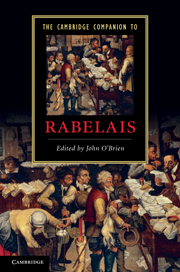Book contents
- Frontmatter
- 1 Introduction
- 2 Reading the works of Rabelais
- 3 Laughing in Rabelais, laughing with Rabelais
- 4 Interpretation in Rabelais, interpretation of Rabelais
- 5 Making sense of intertextuality
- 6 Pantagrueline humanism and Rabelaisian fiction
- 7 Putting religion in its place
- 8 Pantagrue and Gargantua: The political education of the king
- 9 Histories Natural and Unnatural
- 10 Reading and unraveling Rabelais through the Ages
- Guide to further reading
- Index
3 - Laughing in Rabelais, laughing with Rabelais
Published online by Cambridge University Press: 28 January 2011
- Frontmatter
- 1 Introduction
- 2 Reading the works of Rabelais
- 3 Laughing in Rabelais, laughing with Rabelais
- 4 Interpretation in Rabelais, interpretation of Rabelais
- 5 Making sense of intertextuality
- 6 Pantagrueline humanism and Rabelaisian fiction
- 7 Putting religion in its place
- 8 Pantagrue and Gargantua: The political education of the king
- 9 Histories Natural and Unnatural
- 10 Reading and unraveling Rabelais through the Ages
- Guide to further reading
- Index
Summary
Rabelais must surely be one of history's most misunderstood authors. The seventh edition of the Oxford Advanced Learner's Dictionary, published in 2005, gives for “Rabelaisian”: “dealing with sex and the human body in a rude but humorous way,” completely ignoring the by-now undisputed facts about Rabelais: that he was a dedicated Erasmian evangelical (in the sixteenth-century meaning of that term) Christian, whose often-hilarious “chronicles” convey serious messages about religion, good government, good education, the conduct of the Ideal Prince, and the importance of friendship. Moderns may tend to assume that writers must be either serious or comic, but the Renaissance knew better; following the Roman poet Horace's celebrated adage “What's to prevent speaking the truth while laughing?” (Satires 1.1.24), Rabelais, like his mentors Erasmus and Thomas More (who made a joke on the scaffold moments before his execution), was a master at the melding of serious and laughable. This chapter will first provide some Renaissance background on humor, and then examine laughter, laughers, and the laughable in Rabelais's four books.
- Type
- Chapter
- Information
- The Cambridge Companion to Rabelais , pp. 31 - 42Publisher: Cambridge University PressPrint publication year: 2010

